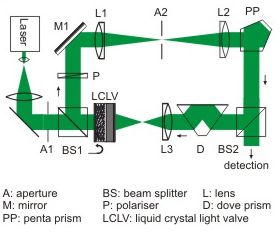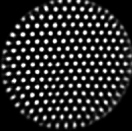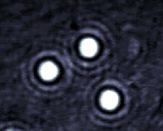The Nonlinearity in the LCLV feedback experiment
In the setup in investigation we use a liquid crystal light valve (LCLV) as optical nonlinearity. A LCLV consists of a liquid crystal layer, a dielectric mirror and a photoconductive layer, which are sandwiched between transparent electrodes. A light distribution incident on the photoconductive layer of the device results in a local alteration of the refractive index of the liquid crystal layer. The amplitude of the refractive index modulation depends on the intensity of the incident light distribution. Such a dependence of refractive index on the light intensity is called optical Kerr effect. Thus a light wave incident on the liquid crystal layer experiences a local phase retardation dependent on the local light intensity incident on the photoconductive layer. The incident light therefore leaves the LCLV after internal reflection with a phase modulation.

Experimental setup of the LCLV feedback system
The feedback scheme
Experimentally the phase modulated light wave is coupled back to the photoconductive layer of the LCLV. This feedback is realised with the help of different optical components (lenses mirrors and prisms) via optical imaging. A section of free space propagation is also inserted in the optical path, which means that the optical beam diffracts and this is equivalent to out of focus imaging. In consequence of this free propagation the phase modulation of the light wave transforms itself into a modulation of the light intensity. The resulting intensity distribution is now incident onto the photoconductive layer of the LCLV, thus closing the feedback loop. Due to the closed feedback loop a self modulation of the light beam in its spatial intensity distribution is enabled. The intensity distribution present in the feedback loop can be monitored with the help of a CCD camera. Note, in contrast to an optical cavity the light wave passes the feedback loop once only and thus the scheme is of single feedback type.
Optical structures
Above a threshold of the input light intensity spontaneously optical patterns and structures form in the single feedback experiment. These structures arise from an uniform intensity distribution. One can more easily understand this process, if one considers that in addition to the uniform intensity distribution also noise is present in the system. The nonlinear feedback now selectively amplifies certain spatial frequencies. Thus noise components with a specific spatial scale start to grow in the system. In consequence a wealth of optical pattern and structures evolves. The spontaneously forming structures have scalings in accordance to the self-amplified spatial frequencies. The wealth of observed patterns ranges from symmetric pattern such as hexagons, stripes and squares, to complex structures, which can also show complex spatio temporal behavior. Also, the possibility to create localized structures exists. Such localized structures can be of interest for application in all optical information processing. Besides of investigating the spontaneous formation of optical structures the activities of our group aim at the control of the spontaneous pattern to make such applications possible [1],[2],[3].

Spontaneously forming hexagon pattern

Image section with localized structures
Localized structures
The formation of Localized structures is enabled, if a bistability between a uniform dark stationary state coexists with a bright patterned stationary state. Briefly illuminating the LCLV's writing side switches the system state of the illuminated area from the uniform dark state to the patterned bright system state, if the system shows bistability at the chosen parameter interval. When the illumination ends, localized bright spots start to from, which are surrounded by a ring structure and which exhibit equal size. These localized states can also be called solitary structures and can be interpreted as optical bits due to the bistability. Similarly to optical solitons they exist due to a balance between diffraction and nonlinear self-focussing. The nonlinear self-focussing induces a Modulation in reflective index structure, which can be potentially used to guide optical data, due to the structure inherent balance between diffraction and self-focussing. If one intents to implement localized structures in application it nonetheless is crucial to develop means of control for unwanted mutual interactions between localized structures and also control over the individual spot positions ins necessary.

